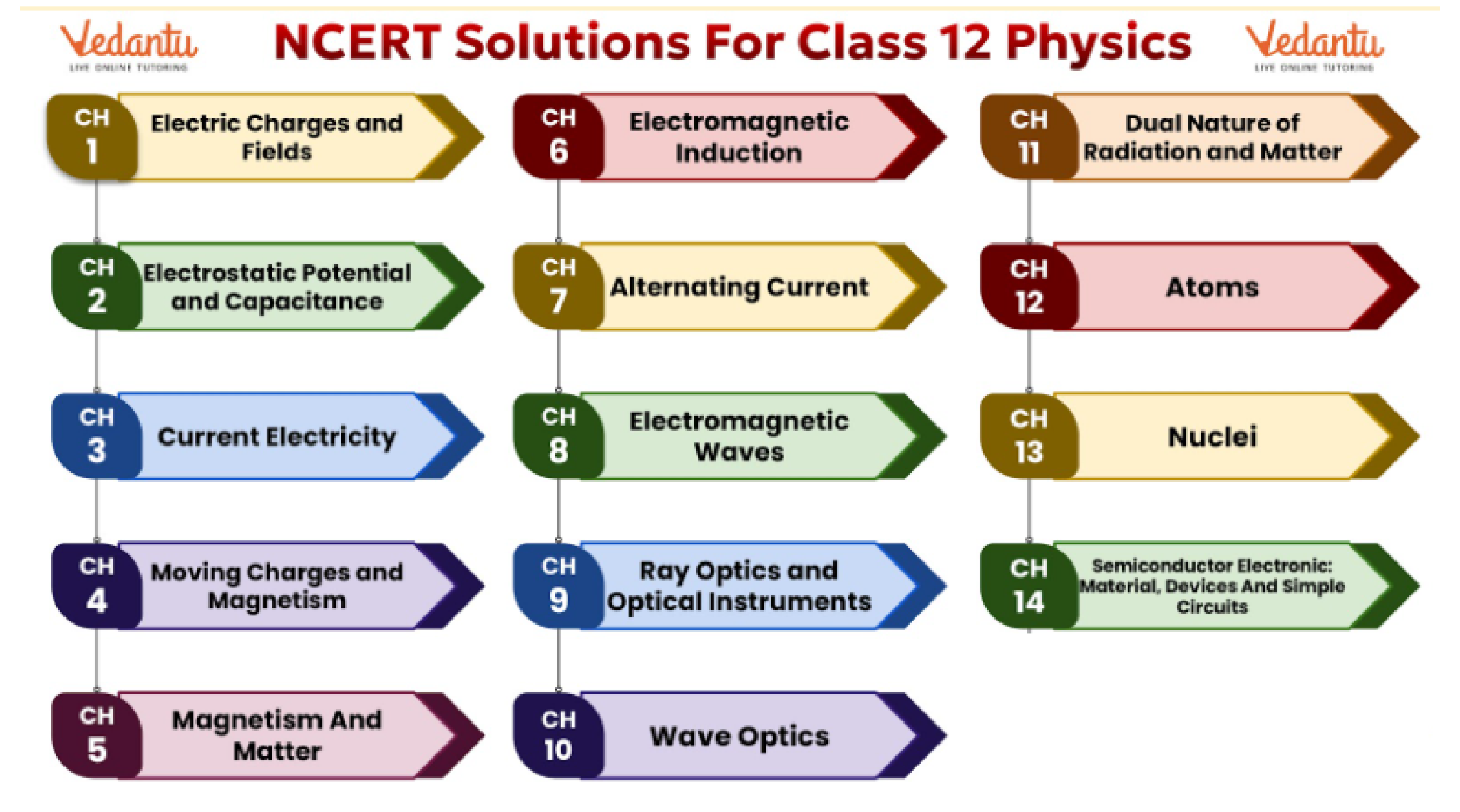NCERT Solutions for Class 12 Physics Chapter-Wise PDF Free Download





















FAQs on NCERT Solutions for Physics Class 12
1. How to Achieve Full Marks in Class 12 Physics Exam?
In order to ace the class 12 Physics exam, students are required to have a conceptual understanding of the entire subject matter. Though all the chapters are equally important, and you should not leave any particular section from your syllabus, there are some sections which you should emphasise on.
A substantial number of questions come from Chapters like Magnetism, Electrostatics, Optics, Communication systems, Semiconductors and Electronic Devices, etc. Students must also note down all the essential formulae, derivations and constant physical values; these will come handy during the revision before the exam. Moreover, you should follow the NCERT books to cover the whole Physics syllabus.
2. How Many Chapters are There in Physics Class 12 NCERT Book? Also, Write the Names.
In total there are 14 chapters in the NCERT book of class 12 Physics. The names are:
Electric Charges and Fields
Electrostatic Potential and Capacitance
Current Electricity
Moving Charges and Magnetism
Magnetism and Matter
Electromagnetic Induction
Alternating Current
Electromagnetic Waves
Ray Optics and Optical Instruments
Wave Optics
Dual Nature of Radiation and Matter
Atoms
Nuclei
Semiconductor Electronics Devices, Materials and Simple Circuits
3. What will a Student Learn in the First Laws of Motion?
The first laws of motion deal with force types, free body diagrams, Newton’s motion laws, equilibrium, constraint equations, pulleys, friction and pseudo force. Moreover, in this topic, students will get to learn about the three motion laws and the relationship between forces acting on the body and motion of the body.
Students will also get an idea about the conservation of momentum along with both initial and final velocity. This topic includes the different collision types, and linear motions like uniform and non-uniform linear motion, including the vector quantities. It is an important chapter that requires a thorough understanding.
4. Can I study from the NCERT Solutions for Class 12 Physics for the exam preparation?
NCERT Solutions for Class 12 Physics are given in detail on Vedantu Website and the app. All solutions are prepared by experts in easy to understand language. Students can refer to the NCERT Solutions for an easy understanding of the concepts given in Class 12 Physics. If students read the chapter from the NCERT textbook and then check the solutions, they can do better preparation for their exams.
5. Is Physics of Class 12 difficult?
Class 12 Physics is a vast subject. It includes a wide range of topics and derivations. But, if students study consistently and pay attention to the basic concepts they can score good marks in Physics Class 12. They should read each chapter attentively and should try to understand the concepts. They have to make a study plan for solving derivations as most chapters have derivations and can help score better.
6. Which is the most important chapter in Class 12 Physics?
All chapters in Class 12 Physics are important. Students should understand the concepts in Physics for getting good marks in exams and for entrance exam preparation. Students can download NCERT Solutions Class 12 Physics from the Vedantu website free of cost. NCERT Solutions Class 12 Physics can help students in understanding the concepts and scoring good marks. They can download PDF files and save them on their computer to refer to anytime for exam preparation.
7. Are Vedantu’s NCERT Solutions for Class 12 Physics free of cost and how to download the NCERT solutions?
Yes, Vedantu’s NCERT Solutions for Class 12 Physics are available free of cost. They need to follow the below steps to download Vedantu’s NCERT Solutions for Class 12 Physics
Visit the page-NCERT Solutions for Class 12 Physics.
Click on NCERT Solutions for Class 12 Physics.
Click on the chapter for which you want the solutions.
Click on the option download pdf.
Students can save these solutions free of cost on their computers and can refer to them offline.
8. Which is the hardest chapter in class 12 physics NCERT solutions?
The hardest chapter in class 12 physics NCERT solutions often varies from student to student, but many find "Electromagnetic Waves" and "Wave Optics" particularly challenging due to their complex concepts and mathematical derivations.
9. Are questions repeated in CBSE board exams for NCERT physics class 12?
While exact questions are rarely repeated, similar types and patterns of questions often appear. It's beneficial to practice previous years' papers to understand the recurring themes and types of questions.
10. What type of questions are asked in NCERT solutions class 12 physics?
Questions in NCERT physics class 12 exam range from theoretical questions, numerical problems, and derivations to application-based questions and multiple-choice questions (MCQs). Emphasis is often on conceptual understanding and the ability to apply formulas and principles to solve problems.
11. How to get 100 marks in NCERT solutions for class 12 physics?
To score 100 marks in NCERT solutions for class 12 physics, focus on:
Understanding concepts thoroughly.
Regularly practicing numerical problems and derivations.
Revising and solving previous years' question papers.
Paying attention to important topics highlighted in the syllabus.
Clarifying doubts promptly and consistently studying.
12. Which is the biggest chapter in class 12 physics NCERT solutions?
"Electrostatics" is often considered the biggest NCERT physics class 12 due to its extensive content, which includes numerous subtopics and detailed derivations.
13. Which part of physics class 12 NCERT physics class 12 solutions is the hardest?
The hardest part of NCERT physics class 12 solutions class 12 physics often depends on individual strengths and weaknesses, but many students find "Electromagnetism" and "Quantum Mechanics" to be particularly difficult due to their abstract concepts and complex mathematics.




